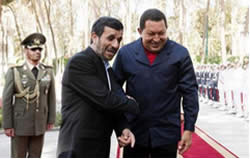
The bill to counter Iranian influence in the Western Hemisphere
(www.govtrack.us website)
Overview
1. On December 29, 2012 President Barack Obama signed into law a bill called The Countering Iran in the Western Hemisphere Act of 2012, which deals with the steps the United States will take “To provide for a comprehensive strategy to counter Iran's growing hostile presence and activity in the Western Hemisphere…”[1] (ITIC emphasis). The bill, which was recently signed into law, was first proposed in the House on January 18, 2012, and was passed by both the House and Senate on December 18, 2012. Its objective is “to use a comprehensive government-wide strategy to counter Iran's growing hostile presence and activity in the Western Hemisphere.”
2. The main points of Bill H.R. 3783 are the following (ITIC emphasis throughout):
1) “Not later than 180 days after the date of the enactment of this Act, the Secretary of State shall conduct an assessment of the threats posed to the United States by Iran's growing presence and activity in the Western Hemisphere and submit to the relevant congressional committees the results of the assessment and a strategy to address Iran's growing hostile presence and activity in the Western Hemisphere.”
2) “In developing the strategy…the Secretary of State shall consult with the heads of all appropriate United States departments and agencies, including the Secretary of Defense, the Director of National Intelligence, the Secretary of Homeland Security, the Secretary of the Treasury, the Attorney General, and the United States Trade Representative… The strategy…may be submitted in classified form, but shall include an unclassified summary of policy recommendations…”
3) “[W]ith respect to the United States borders, in coordination with the Governments of Mexico and Canada and the Secretary of Homeland Security, a plan [will be formed] to address resources, technology, and infrastructure to create a secure United States border and strengthen the ability of the United States and its allies to prevent operatives from Iran, the IRGC, its Qods Force, Hezbollah, or any other terrorist organization from entering the United States.”
3. Interviewed by Iran’s ISNA news agency on December 30, Mansour Haqiqat-Pour, deputy head of the Iranian parliament’s committee for national security and foreign relations, responded to the signing of the law. He said that it indicated Iran’s influence in Latin America (“Iran is already present in the house of the United States but the United States still has not understood that.”) He emphasized that Iran was not a little Middle Eastern state, but rather a political power whose revolutionary message had been transmitted around the globe (ISNA, Iran, December 30, 2012).
4. Since Ahmadinejad was elected president of Iran in August 2005 Iran has expanded and deepened its relations with Latin America. Iran exploits those relations to strengthen its foothold in Latin America to establish political, economic and religious influence and for terrorist and subversive activity. Iran’s links are both direct, and indirect through the Qods Force and Hezbollah. Its activities in Latin America are part of a larger Iranian strategy to extricate itself from political isolation and to present a genuine threat to the United States in its own back yard.
5. Iran implements the strategy by exploiting its relations with Latin American countries and groups within the local populations where anti-American ideology and rhetoric fall on willing ears and where there are Muslim populations, some of them Lebanese Shi'ites. In addition Latin America is also an arena for Iranian crime, subversive and terrorist activities, led by the Iranian Islamic Revolutionary Guards’ Qods Force and other bodies within the Iranian regime. The Iranians also employHezbollah as a subcontractor for its terrorist and subversive activities (sometimes including crime).
| 6. For in-depth information about Iranian activities in Latin America see the April 18, 2012 ITIC bulletin “Latin America as a Terrorist, Subversive, Criminal Arena for Iran and Hezbollah.” Also see the April 19, 2009 bulletin, “Iran increases its political and economic presence in Latin America, defying the United States and attempting to undermine American hegemony. It also foments radical Shi’ite Islamization and exports Iran’s revolutionary ideology, using Hezbollah to establish intelligence, terrorism and crime networks, liable to be exploited against the United States and Israel.” |

Iranian president Ahmadinejad on a visit to Venezuela in January 2012, in the company of Venezuelan president Hugo Chavez (www.almanad.com.lb website).
[1] This and all quotes from the text of the bill, http://thomas.loc.gov/cgi-bin/query/D?c112:5:./temp/~c112UGnjJc::






